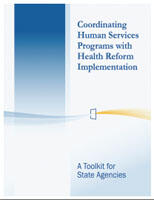- Home
- Coordinating Human Services Programs Wit...
Coordinating Human Services Programs with Health Reform Implementation
A Toolkit for State Agencies
Executive Summary
By making affordable health care available to millions of low-income, uninsured Americans, the Affordable Care Act (ACA) will go a long way towards helping families who struggle on a daily basis to afford life’s most basic necessities. Health care reform’s impact on low-income people’s lives, however, goes beyond providing them health insurance coverage. It has the potential to significantly affect low-income individuals and families’ ability to apply for and receive other benefits, such as the Supplemental Nutrition Assistance Program (SNAP) and child care subsidies, that are critical to helping them make ends meet.
In states that expand Medicaid eligibility in 2014, it is likely that a large share of people (mostly parents and adults without children) who will be newly eligible for Medicaid coverage will already be enrolled in SNAP or other benefit programs. In other cases, individuals who apply for health coverage due to the new law will not have had contact with state human services in the past and many may be eligible for other benefits, such as SNAP, child care subsidies, or energy assistance. Careful consideration of how states will address and leverage applicants’ or participants’ connection to other benefits and services as a part of their health reform implementation efforts could help to yield better outcomes for families and efficiencies for state administration.
Downloadable Resources
Why Use the Toolkit?

States will need to tackle these key questions:
- How will people who apply for human services programs be informed about and given the opportunity to apply for Medicaid? In most states, families who apply for benefits at a local human services office are routinely screened for and, if eligible, enrolled in health coverage. Will that still be the norm in 2014? Or will the poorest families face added burdens to accessing health coverage because they can only seek health benefits through some other process?
- How will low-income people who apply for health coverage through the state’s online application be connected to other human services programs and benefits? When low-income individuals apply for health coverage and qualify for Medicaid, will there be a process to help connect them to other benefits and services for which they might be eligible?
Put another way, will it be harder or easier in 2014 for the poorest families to access (or for states to deliver) the package of services for which they will be eligible, including health coverage?
State choices with respect to these issues will have an enormous impact on poor families’ and individuals’ access to key benefits and services. This toolkit is designed to help states sort through those choices. Specifically, it is intended to guide states in developing an eligibility system and process that meets the standards and requirements of the ACA, with a particular focus on ensuring that poor or near-poor families have a way to access the full package of available benefits. It raises issues and questions that states need to consider to ensure that these families’ experience with obtaining benefits is not only protected, but improved, as states modify and upgrade their systems.
What Does the Toolkit Cover?
Each module of this toolkit provides states with tools and suggestions for a guided process that can be used to review the current eligibility and enrollment service delivery model and compare the current model to the desired future model. The modules provide context on the importance of the topic being addressed and how a state’s decision on the issue can affect a family’s ability to access multiple benefits.
The toolkit covers the following topics:
- Eligibility Process. This module will help states identify decisions about how their eligibility processes and structures will operate in 2014 and beyond. It is intended to facilitate discussion about how decisions related to the ACA will affect overall service delivery of benefits in a state.
- Applications. This module will help states take stock of how well their current applications perform in order to identify additional improvements that should be incorporated in the design of a new, ACA-compliant application. It will also help states identify questions that would need to be added to a Medicaid application to make it a multi-benefit application that can also be used for SNAP and other human services programs.
- Verifications. This module helps states identify opportunities for streamlining verification policies and processes across programs. It starts with a review of states’ current verification practices and walks through issues that states should consider in designing a verification process that minimizes the burden on families.
- Renewals. This module provides a framework for a guided process that state agencies can use to review how they currently conduct renewals, and design a new process to meet the ACA requirements.
- Staff Readiness. This module will help states assess their current staffing model, including taking an inventory of their current position descriptions, organizational structure, performance management system and staff training.
- Project Management and Communications. This module provides states with tools to kick off their planning for ACA implementation. It walks through how to create an outline of a project plan, define team members’ roles and responsibilities, develop a project calendar, and create an outline of a communication plan.
Each module also contains instructions on how to complete the section, including what materials and resources are needed, suggestions for information or data that should be gathered in advance, as well as estimates of the amount of time and effort that states might consider devoting to the process. While the topics covered in each of the sections are interrelated, each section is designed to stand on its own, so that states can complete only certain sections if they so choose.
More from the Authors

